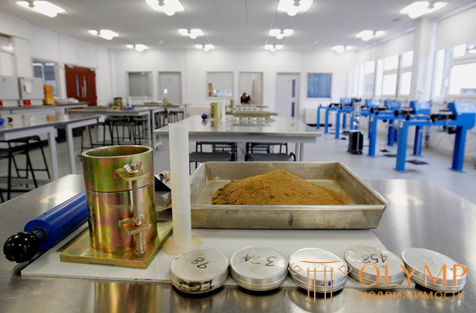
Under laboratory conditions, samples of soils that were selected as monoliths or soil samples of disturbed structure from mining workings or boreholes are studied. Basically, in laboratory conditions, they study the physicomechanical properties of soils, and also perform chemical analysis of groundwater samples. The work package includes the following soil studies:
- determination of humidity;
- determination of density and porosity;
- determination of particle size distribution;
- determination of the limits of plasticity, swelling, stickiness, and razmokaemost;
- determination of water capacity, water loss. and capillary properties;
- determination of water permeability;
- compression tests:
- determination of compressibility indicators;
- definition of indicators of subsidence;
- Shear test to determine the strength properties;
- test in the stabilometer to determine the indicators of mechanical properties;
- determination of indicators of mechanical properties of semi-rock and rock;
Depending on the responsibility of the facility, its purpose and the complexity of the engineering geological conditions, the research complex is carried out in full or in part.
The main attention should be paid to the determination of deformation and strength properties of soils, the indicators of which are used to calculate the bases of buildings and structures. The main parameters of these properties for non-rocky soils are the deformation modulus, the angle of internal friction and specific adhesion, and for rocky soils - the ultimate strength or temporary resistance to uniaxial compression.
The methodology for the compression tests is as follows. From the soil monolith a working odometer ring with an area of at least 40 cm2 and a height of at least 2 cm cut a sample and put the ring with breakdowns in the odometer. Ground pressure is transmitted in steps. Each pressure stage is maintained until conditional stabilization of deformations, for which an increment of sludge is taken, not exceeding 0.01 mm for 3 hours for sandy loams and for 12 hours for loams and clays.
Processing the results consists in plotting the dependence of the porosity coefficient on the vertical pressure and calculating the strain modulus using the appropriate formula.
Characteristics of the deformation behavior of clay subsidence soils are relative subsidence and initial subsidence pressure. They are determined in a compression device according to two schemes:
“One curve” - to determine the relative subsidence at one given pressure;
"Two curves" - to determine the relative subsidence at different pressures and initial subsidence pressure.
Tests according to the “one curve” scheme are carried out by loading a sample of the soil of natural moisture in steps of 0.05 MPa to a predetermined pressure. After the conditional stabilization of its precipitation at a given pressure, the soil sample is soaked and the soaking is continued until the conditional stabilization of the subsidence.
Tests according to the “two curves” scheme are carried out on two soil samples taken from one monolith. One sample is tested in full accordance with the first scheme, and the second sample is pre-soaked to full water saturation. Soaking begin 3 hours before the beginning of the test of subsiding sandy loams and 6 hours during the testing of subsidence loams and clays. Then the sample is loaded with the same steps to a predetermined pressure, continuing its soaking.
The test results are processed by plotting the dependence of the relative compression of samples on pressure and calculating the relative subsidence, as well as plotting the relative subsidence of pressure on pressure and determining the initial subsidence pressure, which corresponds to a relative subsidence of 0.01.
Characteristics of the deformation behavior of swelling soils are relative swelling and swelling pressure. These characteristics are determined by the results of compression tests of several soil samples. Selected for testing soil samples are placed in compression devices and compacted with different pressures until the conditional stabilization of the sediment. Then the samples are soaked under pressure applied to them. The readings on the indicator are taken in 5, 30, 60 minutes and then every hour for 6 hours, on the next day - twice. The experience is considered complete if during the day the readings of the indicator differed by no more than 0.01 mm.
After completion of the tests, relative swelling is calculated for each sample. Based on the calculated values of the relative swelling, a graph is plotted against pressure.
The method of implementation and the results obtained for some other types of laboratory work are given in Section 7.
Test examples
Compression test soil
Uniaxial compression soil testing (E) for rocky soil
Single-plane soil testing
Testing the soil using the triaxial compression vibro method (kd (vibro))
Triaxial soil tests with unloading
Triaxial soil testing (F, C and E)
Triaxial soil testing (seismic dilution)
Primary and secondary consolidation
Freeze cut
Plaxis-ocr
Plaxis-ohde
Plaxis-dilatancy slice
Side pressure coefficient
Plaxis-Unloading

Что бы оставить комментарий войдите
Комментарии (0)